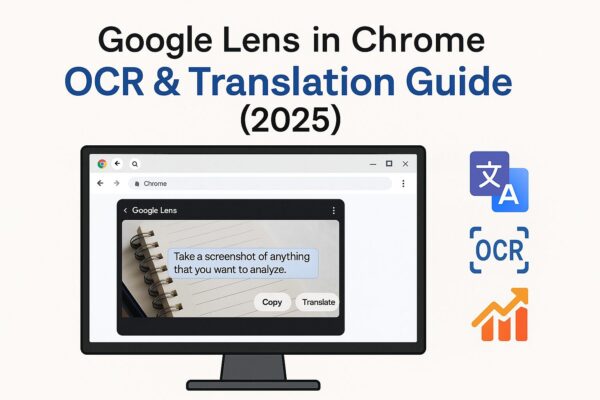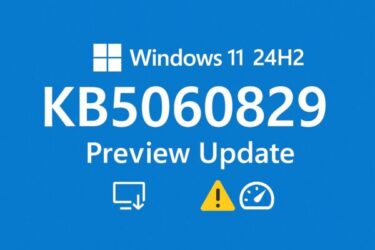
Introduction
Do you ever find yourself staring at an image, screenshot, or PDF file on your computer, wishing you could just copy the text or translate it instantly?
With recent versions of Google Chrome, you don’t need a separate app or even a smartphone.Thanks to built-in support for Google Lens, you can now extract text, translate languages, or search for visual content—directly from your browser.
This guide will walk you through how to use Google Lens on your computer, especially for OCR (Optical Character Recognition) and translation tasks—perfect for students, professionals, and multitaskers alike.
What Can Google Lens Do in Chrome?
Here’s a quick overview of what’s possible with Google Lens inside Chrome for desktop:
| Function | Description |
|---|---|
| Copy text from images | Extract readable text from screenshots or photos |
| Translate text | Instantly translate foreign-language text found in images |
| Search by image | Identify places, products, or concepts shown in a picture |
| Select and analyze | Choose any area on a webpage and search it visually |
| Paste and analyze images | Drag-and-drop or paste a screenshot directly into Chrome |
Google Lens in Chrome isn’t just a search tool—it’s a versatile feature that turns your browser into a smart assistant. Whether you’re working with foreign-language documents, visual-heavy PDFs, or screenshots from software tutorials, Lens can help you save time and reduce manual work.
Most of these features are available by simply right-clicking on an image or selecting a portion of your screen. No need to install extra software or switch between devices.
In the next sections, we’ll walk you through how to use each of these features step by step—so you can make the most of Google Lens in your daily workflow.
How to Use Google Lens in Chrome (3 Ways)
1. Use Right-Click on an Image
- Right-click on any image inside your browser.
- Choose “Search image with Google Lens.”
- A new tab will open with extracted text, translations, or related content.
This is the easiest way to analyze visual content—no extra tools required.
2. Select a Portion of Your Screen
- Right-click on any blank area of a webpage.
- Click “Search selected area with Google Lens.”
- Your mouse cursor turns into a selection tool. Drag to highlight the target area.
- The right panel will show results based on the selected region.
Useful when only part of the page contains relevant information—like a graph, a scanned diagram, or non-selectable text.
3. Paste or Drag-and-Drop an Image
- Take a screenshot (for example, using Snipping Tool).
- Open a new tab in Chrome and drag-and-drop the image, or press Ctrl + V to paste.
- Google Lens will automatically detect text or visual content.
This is especially powerful for scanned PDFs, screenshots from YouTube, or UI text from software windows.
Translate Text in Images (Multilingual Support)
Google Lens supports a wide range of languages, including Japanese, Chinese, Spanish, German, Arabic, and more.
You can:
- Translate signs or menus from foreign countries
- Understand study materials or documentation in other languages
- Compare translated and original text side-by-side
Perfect for international travelers, students, or remote teams working across borders.
Best Use Cases for Work, Study, and Daily Life
Business & Productivity
Use Google Lens to quickly:
- Extract information from charts or scanned documents
- Translate technical manuals or infographics
- Collect data from images for email drafts or reports
From marketing teams extracting quotes from infographics, to engineers translating product manuals in real time—Google Lens offers a seamless way to interact with visual content. It minimizes the need for retyping, speeds up multilingual collaboration, and helps you focus on actual decision-making rather than copy-paste work. If your job involves research, reporting, or visual documentation, this tool can quietly become one of your biggest time-savers.
Education
Great for:
- Translating text in academic papers or lecture slides
- Searching difficult terms directly from screenshots
- Preparing multilingual study notes
Whether you’re a student reviewing lecture slides or a teacher preparing bilingual materials, Google Lens helps eliminate barriers caused by non-editable text. You can quickly copy quotes from textbooks, translate diagrams in science PDFs, or search unfamiliar terms from screenshots—making studying more interactive and accessible. It’s especially useful for learners in international programs or those using online resources in multiple languages.
Everyday Tasks
Try it for:
- Reading foreign recipes or product packaging
- Translating posts on social media
- Identifying products or locations from pictures
Even in daily life, Google Lens can simplify small but frequent tasks—like reading food packaging in a foreign language, understanding social media posts from international friends, or quickly identifying a product you’ve seen in a photo. It’s a quiet productivity boost that blends seamlessly into your routine.
Privacy & Security Tips
- Avoid using Lens to analyze sensitive data (e.g., passwords or ID numbers).
- Chrome may keep history of searches unless you’re using Guest Mode or Incognito Mode.
- For work-related tasks, consider using separate Chrome profiles to keep things organized and secure.
While Google Lens is designed with convenience in mind, it’s always smart to think twice before uploading sensitive images. For extra privacy, you can clear your browser history after use or rely on Incognito Mode when working with personal files. These small habits help ensure that your workflow stays both efficient and secure.
Conclusion
Google Lens in Chrome is more than just a search tool—it’s a powerful OCR, translation, and productivity assistant right in your browser.
Whether you’re analyzing study materials, extracting content for a report, or translating images from around the world, Chrome + Lens is a must-have combination for 2025.
Try it out today—no extensions or apps required. Just right-click and explore.
💡 Looking for more tips? Check out our full list of Windows Help Guides.


